Lesson 7A
Period of “Burning books
and arresting intellectuals”
Before 1975, the proletariat culture was directed by the Đề cương văn hóa (Culture Manifest) applied in North Vietnam under the absolute control of the Communist government while they proceeded their invasion and conquest in the South. After they succeeded in capturing Saigon on April 30, 1975, the Communists activated a movement aimed at destroying the culture of the South by:
– Burning books and arresting intellectuals,
– Destruction of music and inhibition of songs.
Burning books and arresting intellectuals
Talking about burning books and arresting intelectuals, may people immediately think of the event of “Phần thư, khanh nho (焚 書 坑 儒) = Burn book, Bury alive intellectuals” that happened under the reign of Qin Shi Huang (Tần Thủy Hoàng, the first Chinese emperor, 259-210 BC). According to Shiji (Sử Ký) by Sima Qian (Tư Mã Thiên, 145 or 135 – 86 BC), in 213 BC, Li Si (Lý Tư, 280-208 BC), Imperial Chancellor under Qin Shi Huang, advocated the burning of all books (old classics of One Hundred Schools of Thought = Bách Gia Chư Tử, Book of Odes =Kinh Thi, Book of Documents = Kinh Thư …). Li Si said: “I am here respectfully submitting the policy of burning all books, except for the books produced under our Qin Dynasty. Any books that do not belong to the category of allowed books, being kept by the populace, such as Book of Odes, Book of Documents … as well as books by the One Hundred Schools of Thought must be brought to local administrators to be burned[1]”. After a thorough investigation and interrogation done with all intellectuals, 450 of them were selected for their violations and buried alive in Xianyang in 210 BC.
In the history of Vietnam, there was also a planned book burning ordered in the decree issued by Ming Cheng Zu (Minh Thành Tổ, 1403-1424) to Zhu Nang (Chu Năng, dead on his way to conquer Annam) and Zhang Fu (Trương Phụ, 1375-1449): “Once the soldiers are already in Annam, all kinds of books, including folk songs, children’s books, any book any word must be burned all over the country, all steles erected by Annam must be destroyed, not a single word left[2]”.“In the 7th Month of the Year of the Dog (1418), Ming Dynasty also ordered Xia Shi (Hạ Thi) and Xia Qing (Hạ Thanh) go to Annam, searching and confiscating all books written on history and legends by the Annamese people[3]”. This disgusting action by the Ming Dynasty in the history of book burning was repeated by the Vietnamese Communist Government at the end of May 1975 after their conquest of Saigon.
The book burning was carried out during the operation of “bài trừ văn hóa đồi trụy, phản động = proscription of debauched and reactionary culture” by exciting and ordering young people and students to go search house by house and confiscate all books for burning. This book burning was acclaimed by the government press and propaganda system. The daily journal Sài Gòn Giải Phóng = Liberated Saigon, in its issue of May 25, 1975, reported: “Ngày 25/5/1975, trên nhiều đường phố Sài Gòn, “khí thế ra quân” của chiến dịch vô cùng sôi nổi: Đoàn thanh niên nam nữ đi qua các đường phố và hô to nhiều khẩu hiệu đả đảo văn hóa ngoại lai đồi trụy mất gốc phản động. Đi đầu là xe phóng thanh với một biểu ngữ dài có ghi: “Đội thanh niên học sinh xung kích bài trừ văn hóa dâm ô phản động,” theo sau là sinh viên học sinh …” = On May 25, 1975, on many streets of Saigon,“the attack momentum” of the operation is so boiling: The group of boys and girls was marching through the streets, shouting many slogans condemning the foreign, debauched and reactionary culture. At the head of the procession was a truck having high-volume amplifiers and carrying a streamer with the following inscription: “Front line youth and students against debauched and reactionary culture,” followed by university and high school students …”
After having captured Saigon, the Communists’ urgent task was to seal, to confiscate books in libraries, and in large bookstores (Khai Trí, Sống Mới, Nam Cường …). All government levels from wards to city issued instructions to concentrate all kinds of books, from novels, periodicals to research studies, for burning. There were two methods to avoid the burning: selling in kilograms to the paper producing factories, or re-selling to sidewalk book vendors.
In October 1975, the daily journal Sài Gòn Giải Phóng printed by many successive issues the list of titles of books by 56 authors, which were banned from circulation. Next came the arrest and emprisonment of authors symbolizing the cultural cream of the cream of the South, aimed at destroying the soul of Saigon, i.e., the culture of freedom and democracy, the culture of the creativity, of the natural development following the principles of nation, humanity and openness.

Demonstration of members of the City Youth League in Book Burning Operation
Following the operation of “burning books and arresting intellectuals” was the imposing of the proletariat culture upon Saigon by:
– Arresting the creators of the culture of freedom and democracy (novelists, artists …) and incarcerating them in re-education camps[4].
– Suppression of free press and printing …
– Control of households by family registry system, police state,
– People being forced to go to propaganda meetings, to learn to sing songs praising Uncle Ho, the Party …
All of these methods and tools were introduced from the North with the objective of transforming the Saigon culture into the proletariat culture.
Era of “Innovation” from 1986
After some time of imposing the proletariat culture followed by an economic crisis, the Communists realized that their policy was no longer working for the following reasons:
– The old tools like the family registry system and the police control were no more effective.
– In the era of globalization with the high-speed electronic communication systems, in spite of the existing suppression of a free press and censorship of the printing industry, people were still able to have contact with the free world.
– In the era of peace and market economy, the urban and industrial culture, freedom and democracy … were more compatible with people’s life.
Because of the above-mentioned reasons, the imposition of the socialist culture upon the Vietnamese people has failed and created a cultural vacuum. From this cultural vacuum, the traditional culture has been revived in the countryside of the North, and the Saigon culture (áo dài, music, literature …) has come back like a storm over all the cities. This cultural tornado symbolized:
– The impotence of the Communist government facing with the unwanted cultural assimilation: the winners (outdated culture) were culturally assimilated by the losers (advanced culture),
– The victory won by Saigon on the cultural front despite its military defeat.
Wave of Saigon’s uprising
Today, coming back to Saigon you will see what was meant by this old saying: “Nhất ba tải động, vạn ba tùy = One wave creates the movement, ten thousand waves depend on it.” The reality means that the thought wave of traditional Saigon has started and created ten thousand different waves, such as the coming back of the áo dài, the free display and sale of old books everywhere, the sounds of old songs of “the losers” heard in tea rooms, entertaining bars …
This era of the resurrection of Saigon culture was highlighted by the following two remarkable literary events:
– The presence of many old writers, poets in Saigon,
– Story books printed in Saigon before 1975 are now displayed and for sale in many old-book stores and on the street for the “read” culture of Saigon.
The coming back of writers and poets
It happens when on Nguyễn Văn Bình Street, the street of book selling, right in the centre of District 1, books by Nguyễn Mạnh Côn, Vũ Khắc Khoan, Nghiêm Xuân Hồng, Võ Phiến, Dương Nghiễm Mậu, Lê Tất Điều are freely displayed and for sale …
It happens when writers and poets of the old Saigon such as poet Du Tử Lê, writer Phan Nhật Nam, former captain of the Airborne Division, were invited by writer Huy Thịnh to come back for a meeting with the Hanoi Association of Writers (but Phan Nhật Nam refused to come).
These facts are sufficient to declare that the old Saigon literature has resurrected and is creating crushing waves flowing through Vietnamese people’s minds, which will flow incessantly[5].
These waves have become officialised with the creation of the streets for the “read” culture in large cities.
Streets for the “read” culture of Saigon
After almost three months of construction, the Đường Sách Nguyễn Văn Bình (Nguyễn Văn Bình Book Street) was officially inaugurated on January 9, 2016[6]. This small street, only 144 m long, 8 m wide, with both sidewalks measuring 6 m, is designed to have 20 book stalls on one side, and book cafes and exhibition space on the other side. At one end of the street was the sign for the book street and a sculptured statue named Cô gái bên trang sách (The Girl Beside the Book Page). At the other end, connecting to Hai Bà Trưng Street is another statue named Suy ngẫm (Thinking). The majestic sign, higher than a real person, has this inscription: “Không Cần Phải Đốt Sách để phá hủy một nền văn hóa, Chỉ Cần Buộc Người ta Ngưng Đọc mà thôi” (You don’t have to burn books to destroy a culture. Just get people to stop reading them). [sic] It is stated that this statement was made by Mahatma Gandhi but it was really made by writer Ray Douglas Bradbury[7].
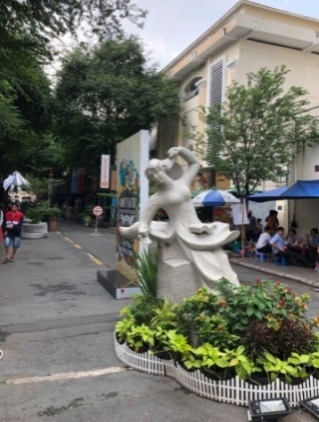
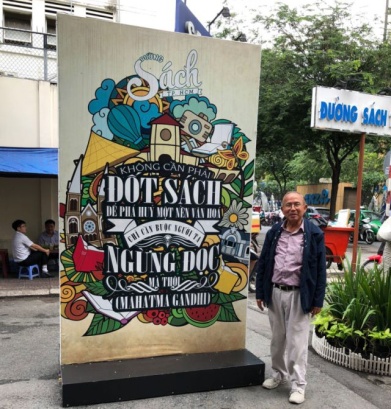
The statue The Girls Beside the Book Page The sign “You don’t need to burn books…”
(Photo by Dr. Ngô Thế Vinh)


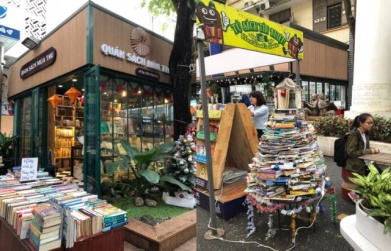
Scenes of Nguyễn Văn Bình Book Street
Activities on the Book Street
Where do you go to buy the old books published during the time of the Republic of Vietnam? You only need to go to Nguyễn Văn Bình Book Street in District 1. For example, Quán Sách Mùa Thu (Autumn Book Stall) with the following inscription: “Về lại chốn thư hiên” (Coming back to the book penthouse) is where you can buy or order old and rare books, “relics of the Mỹ Ngụy (American and Usurpers) culture.” Besides, the Book Street also offers the following activities:
– Week of Áo Dài Exhibition,
– Trịnh Công Sơn Week,
– Painting, sculpture exhibitions,
– Meetings between writers,
– Exchanges between authors and readers,
– New book launches for in-country and overseas authors.
On November 5, 2016, historian Dr. Nguyễn Duy Chính, coming back from the United States for the launch of his gigantic 10-volume research book on the Tây Sơn era and its diplomatic relations with the Qing Dynasty at the Văn Hóa Văn Nghệ Publishing House book stall.
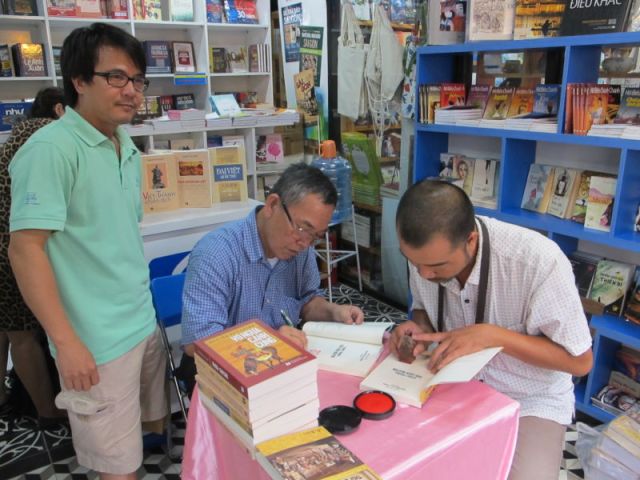
Historian Dr. Nguyễn Duy Chính (in the middle)
(Source: Dr. Nguyễn Duy Chính)
Writer Nguyễn Thị Thụy Vũ, after almost half a century living in seclusion, now at her age of 80, was present on Nguyễn Văn Bình Book Street to launch a series of 10 of her books recently re-published by the Phương Nam Publishing House.
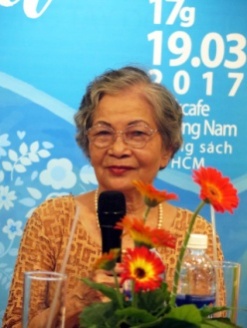
Writer Nguyễn Thị Thụy Vũ (Source: Photo by L. Điền TTO)
Professor Larry Berman, from U.C. Davis, launched his new book The Perfect Spy at the First News book stall of the Book Street on January 23, 2016 (Source: Photo by BTC, Báo Thanh Niên)
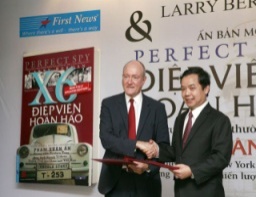
The British Council has selected Nguyễn Văn Bình Book Street to organize the activities for the 400th Death Anniversary (1616-2016) of William Shakespeare.
-
An example of the results of the book burning policy: During the Eastern Zhou (770-221 BC), China was divided into several vassal states; Chinese literature developed from the VI to the III centuries BC with Laoism, Confucianism, Mohism, Mencius, Xun Zi, Yang Zhu … bringing Chinese culture to the top of the world. And then for the next 2,000 years, China could not produce any significant philosopher. Why? Reason: Under the reign of Qui Shi Huang, Li Si’s submitted policy of burning books and burying alive intellectuals (450 opposing intellectuals). What happened after that was : “Trăm hoa hết đua nở, trăm nhà đều im tiếng = Hundred flowers stopped blossoming, hundred houses stopped speaking.” ↑
-
Trần Ngọc Thêm, Tìm về bản sắc văn hóa Việt Nam = In search of the Vietnamese cultural identity, Ho Chi Minh City Publishing House, 1996, p. 485. ↑
-
Trần Quốc Vượng, Văn hóa Việt Nam: tìm tòi và suy nghĩ = Vietnamese culture: searching and thinking, National Culture Publishing House, Hanoi, 1999, p. 755. ↑
-
Composer Nguyễn Văn Đông, authors Dương Nghiễm Mậu, Duyên Anh … were put in prison; some of them such as poet Vũ Hoàng Chương and novelist Nguyễn Mạnh Côn were dead while in prison. ↑
-
“After 1975, the Communists created the “Liberation Literature of the South” with a few renowned authors such as Vũ Hạnh, Lữ Phương … the rest were fake names; that’s why this literature was also a fake literature, which was at the end forgotten and erased. This phenomenon of taking the fake to replace the real still exists in the official literary activities and in the education provided in the current school system.” (Thụy Khuê, Literature of the South. ↑
-
The other streets for old books are: Trần Nhân Tôn (District 5), Trần Huy Liệu (District of Phú Nhuận), Nguyễn Thị Minh Khai (near the 7-street intersection Lê Thái Tổ). The Second Project for Book Street in Saigon is for District 7 on Nguyễn Đổng Chi. Other book streets are also planned for Vũng Tàu, Cần Thơ, and Hà Nội. ↑
-
“The problem in our country isn’t with books being banned, but with people no longer reading. Look at the magazines, the newspapers around us … it’s all junk, all trash, tidbits of news. The average TV ad has 120 images a minute. Everything just falls off your mind … You don’t have to burn books to destroy a culture. Just get people to stop reading them.” ↑

